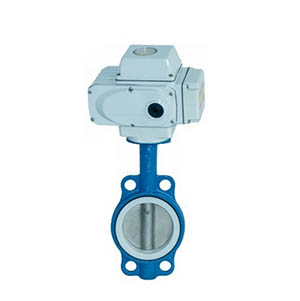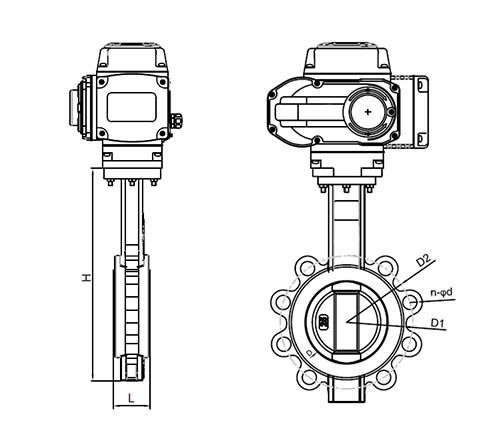How to Install Electric Butterfly Valve?
With the development of electric valves, many well-known valve companies at home and abroad produce electric valves. Electric butterfly valves are important execution units in the field of industrial automation and control. The electric butterfly valve is a kind product of electric valve and electric regulating valve. The electric butterfly valve can be divided into flange type and wafer type butterfly valve ( ato possess product 8 inch elecrric wafer butterfly valve). The electric butterfly valve controls the switch of the butterfly valve through the power signal.
Industrial butterfly valves have the characteristics of high temperature resistance, large applicable pressure range and large nominal valve diameter. Large high temperature butterfly valve is welded by steel plate. Mainly used for high temperature medium flue gas pipeline.
Because electric butterfly valves are widely used in textile, power station, petrochemical, heating and refrigeration, pharmaceutical, shipbuilding, metallurgy, light industry, environmental protection and other fields, it is very important for people to install electric butterfly valves correctly. So how do we need to install the electric butterfly valve? Let's find out next.
Preparation before installation
Before installation, the electric butterfly valve should confirm whether the product performance and the factory  medium flow direction arrow are consistent with the movement situation, and insert and clean the valve cavity. Foreign matter is not allowed on the sealing ring and butterfly valve plate. Do not close the butterfly plate before cleaning, so as not to damage the sealing ring. The electric butterfly valve can be installed on the riser, so it is not limited by the position and direction. A butterfly valve refers to a valve whose closing member is a disc that rotates around an axis to open and close. It mainly plays the role of cutting and throttling the pipeline.
medium flow direction arrow are consistent with the movement situation, and insert and clean the valve cavity. Foreign matter is not allowed on the sealing ring and butterfly valve plate. Do not close the butterfly plate before cleaning, so as not to damage the sealing ring. The electric butterfly valve can be installed on the riser, so it is not limited by the position and direction. A butterfly valve refers to a valve whose closing member is a disc that rotates around an axis to open and close. It mainly plays the role of cutting and throttling the pipeline.
The opening and closing part of the butterfly valve is a disc-shaped butterfly plate, which rotates around its own axis in the valve body to achieve the purpose of opening and closing or adjustment.
The fully open to fully closed electric butterfly valve is usually less than 90 degrees. Butterfly valves and butterfly stems have no self-locking ability. In order to position the electric butterfly valve plate, the worm gear reducer should be installed on the valve stem. The use of worm gear reducer can not only make the butterfly valve plate have self-locking ability, so that the electric butterfly valve plate can stop at any position, but also can improve the operating performance of the valve. In addition, we should also pay attention to the following aspects:
- After opening the box, the valve should be installed in time. Do not loosen any fastening screws or nuts on the valve at will.
- The electric butterfly valve can be installed on the pipeline at any angle. For the convenience of maintenance, it is recommended not to install it upside down.
- When installing the butterfly valve flange, it must be ensured that the flange surface and the sealing rubber are centered, the screws are tightened evenly, and the sealing surface must be completely fitted. If the screw tightening force is uneven, the rubber protrusion will block the butterfly plate, or leakage at the valve stem against the butterfly valve plate.
Installation electric butterfly valve steps
The most recommended installation of the electric butterfly valve is to place it horizontally, so that the bearings at both ends will not be at the bottom, and it can also prevent the sediment in the medium from entering the bearings. Considering that there are elbows and T-shaped pipes on the water inlet side of the electric butterfly valve, which will cause fluid bending and uneven distribution, the bias flow must be evenly arranged on both sides of the butterfly valve plate to avoid uneven stress on both sides of the butterfly valve plate.
Place the valve between the two pre-installed flanges (flange butterfly valves need to prepare the gasket positions at both ends), and gently insert the bolts and nuts at both ends into the corresponding flange holes at both ends (flange butterfly valves need to be adjusted gasket position), tighten the nut slightly to correct the flatness of the flange face.
gently insert the bolts and nuts at both ends into the corresponding flange holes at both ends (flange butterfly valves need to be adjusted gasket position), tighten the nut slightly to correct the flatness of the flange face.
Then the flange is fixed on the pipeline by spot welding technology, and the valve is removed. Weld and fix the flange on the pipeline completely, and install the valve after the welding joint cools down. This ensures that the valve has enough space in the flange to prevent the valve from being damaged and the butterfly valve plate has a certain opening (flange butterfly valve needs to be sealed).
Correct valve position and tighten all bolts, being careful not to overtighten. Then open the valve to ensure that the butterfly valve plate can open and close freely, and then slightly open the valve plate. Tighten all the nuts with cross equalization, reconfirm that the butterfly valve can open and close freely, and pay attention to confirm that the butterfly valve plate does not touch the pipe.
The opening and closing stroke of the control mechanism has been adjusted when the electric butterfly valve leaves the factory. In order to prevent the wrong direction when the power is turned on, the user must manually open it to the half (50%) position before turning on the power, and then press the electric switch. Check the switch and the direction of the indicator plate to open the valve.
The crank arm of the pneumatic actuator has a square head structure and is used as a manual device. In case of failure, remove the air source pipe and directly use a manual wrench to realize manual operation. Before using the pneumatic butterfly valve, it should be confirmed that the valve is fully opened and the pipeline is flushed to prevent welding slag and other debris from scratching the sealing surface.
The pneumatic butterfly valve can be installed vertically or lying down within a horizontal range of 180°. Do not place the pneumatic actuator upside down. Pneumatic butterfly valves are generally equipped with bypass pipelines. When overhauling or replacing pneumatic butterfly valves, the bypass pipeline can be used to use the process as usual.
Precautions
- When installing the butterfly valve, pay attention to the flow direction mark on the valve body, so as to avoid the wrong flow direction and affect the use. If leakage is found in the stuffing box during use, it can be solved by tightening the gland bolts.
- The electric butterfly valve needs to adjust the flow rate during use, and it is controlled by a worm gear box. For disc valves with a large number of opening and closing times, open the worm gear box cover after about two months to check whether the butter is normal and keep an appropriate amount of oil.
- Check whether the connecting parts need to be pressed tightly, that is to say, to ensure that the seal packing are filled and the flexible rotation of the valve stem can be guaranteed.
- Metal seal butterfly valve products are not suitable for installation at the end of the pipeline. If it must be installed at the end of the pipe, an outlet flange should be installed to prevent excessive accumulation and positioning of the sealing ring.
- Electric Butterfly Valve Stem Installation Response Regularly check the use effect of the valve, and deal with any faults in time.

